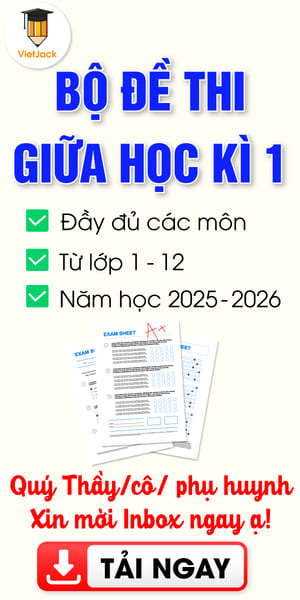Giáo án Tiếng Anh lớp 5 Global Success Unit 7 Lesson 1
Giáo án Tiếng Anh lớp 5 Global Success Unit 7 Lesson 1
Chỉ từ 200k mua trọn bộ Kế hoạch bài dạy (KHBD) hay Giáo án Tiếng Anh lớp 5 Global Success bản word chuẩn kiến thức, trình bày đẹp mắt, dễ dàng chỉnh sửa:
- B1: gửi phí vào tk:
1133836868- CT TNHH DAU TU VA DV GD VIETJACK - Ngân hàng MB (QR) - B2: Nhắn tin tới Zalo VietJack Official - nhấn vào đây để thông báo và nhận giáo án
I. OBJECTIVES
By the end of this lesson, pupils will be able to:
1. Knowledge and skills
- understand and correctly repeat the sentences in two communicative contexts focusing on asking and answering questions about someone’s favourite school activity.
- correctly say the phrases and use What school activity does he / she like? – He / She likes ____. to ask and answer questions about someone’s favourite school activity.
- use What school activity does he / she like? – He / She likes ______. in a freer context.
2. Competences
- Critical thinking and creativity: learn how to ask and answer questions about personal information correctly and fluently.
- Communication and collaboration: work in pairs and groups to complete the learning tasks.
- Self-control & independent learning: perform pronunciation and speaking tasks.
3. Attributes
- Show their pride in their school and show their interest in their favourite school activities.
II. MATERIALS
- Pupil’s book: Page 50
- Audio tracks 66, 67
- Teacher’s guide: Pages 110, 111, 112, 113
- Website hoclieu.vn
- Flash cards/ pictures and posters (Unit 7)
- Computer, projector, …
III. PROCEDURES
1. WARM-UP & REVIEW (5 minutes)
a. Objectives
- To revise the previous lesson by playing Collect the letters.
b. Content
- Game: Collect the letters
c. Expected outcomes
- Pupils can correctly spell some words they have previously learnt.
d. Organisation
TEACHER’S ACTIVITIES |
PUPILS’ ACTIVITIES |
CONTENT |
Game: Collect the letters (ppt) | ||
|
- Greet the class. Ask pupils to play Collect the letters to review the words play football, sing, dance, play the violin, play the guitar, paint. - Ask pupils to unscramble the letters to guess the hidden word “SCHOOL”. - Get pupils to open their books at page 50 and look at Unit 7, Lesson 1, Activity 1. Write the title Our favourite school activities on the board and read it for the class to repeat a few times. Tell pupils what they will learn in this lesson. - Invite one pupil or a group to perform the song in front of the class. |
- Pupils listen to the teacher’s instructions and play the game. - Pupils open their books. - Pupils listen and repeat the title. |
- Vocabulary: play football, sing, dance, play the violin, play the guitar, paint. |
e. Assessment
- Performance products: Pupils’ performance and pronunciation
- Assessment tools: Observation
2. ACTIVITY 1: EXPLORATION (5 minutes)
a. Objectives
- To understand and correctly repeat the sentences in two communicative contexts (pictures) on the phone, focusing on greetings, asking and answering questions about someone’s favourite school activity.
b. Content
- Activity 1. Look, listen and repeat.
c. Expected outcomes
- Pupils can understand and correctly repeat the sentences in two communicative contexts (pictures) focusing on asking and answering questions about someone’s favourite school activity.
d. Organisation
TEACHER’S ACTIVITIES |
PUPILS’ ACTIVITIES |
CONTENT |
|
Activity 1. Look, listen and repeat. (Track 66) | |||
|
Step 1: Ask pupils to look at Pictures a and b and identify the characters and say what they can see in the pictures. Step 2: Have pupils look at Picture a and say what the characters are talking about. Pupils can use Vietnamese, then you repeat their responses in English. Step 3: Play the recording and encourage pupils to point at the characters while listening. Play the recording again, sentence by sentence, for pupils to listen and repeat individually and in chorus. Correct their pronunciation where necessary. Repeat the same procedure with Picture b. Step 4: Invite a few pairs of pupils to listen and repeat the Exchanges a and b. Step 5: Draw their attention to the question What school activity does he like? and the answers He likes reading books. Tell pupils that the question and answer are used to ask and answer questions about someone’s favourite school activity. |
- Pupils look at Pictures a and b and identify the characters in the pictures. - Pupils look at Picture a and listen to the recording. - Pupils listen to the recording again, sentence by sentence, and repeat individually and in chorus. - Pairs of pupils come to the front of the classroom to listen to and repeat the sentences in the recording.
|
– Context a: Mai on the phone to Ben, telling him that she’s helping her brother solve a maths problem Ben: Hi, Mai. What are you doing? Mai: Hello, Ben. I’m helping my brother solve a maths problem. – Context b: Mai telling Ben about her brother’s favourite school activity Ben: What school activity does he like? Mai: He likes reading books. |
|
e. Assesment
- Performance products: Pupils’ answers and pronunciation
- Assessment tools: Observation; Questions & Answers
3. ACTIVITY 2: KNOWLEDGE CONSTRUCTION (10 minutes)
a. Objectives
- To correctly say the phrases and use What school activity does he / she like? – He / She likes ___. to ask and answer questions about someone’s favourite school activity.
b. Content
- Activity 2. Listen, point and say.
c. Expected outcomes
- Pupils can correctly say the phrases and use What school activity does he / she like? – He / She likes . to ask and answer questions about someone’s favourite school activity.
d. Organisation
TEACHER’S ACTIVITIES |
PUPILS’ ACTIVITIES |
CONTENT |
Activity 2. Listen, point and say. (Track 67) | ||
|
Step 1: Have pupils look at Pictures a, b, c and d, say what they can see in the pictures. Point at each picture and the phrase under it for pupils to say it and the meaning. Compare the verb form in the question: What school activity does he / she like? with the one in the answer He / She likes ___. Tell pupils that in the question, the verb like follows does, so is in the base form (like). But in the answer, like + s must be used after the subject He or She. Remind pupils of the structure: like + Verb with -ing as well. Step 2: Play the first part of the recording for pupils to listen to and repeat the phrases under the pictures in chorus and individually until they feel confident. Use the related flash cards for the class to practise speaking. Step 3: Draw pupils’ attention to the speech bubbles and elicit the missing phrase in the answer by pointing at Picture a. Play the second part of the recording for pupils to listen to and repeat the sentences in both bubbles a few times. Repeat the same procedure with Pictures b, c, and d. Step 4: Let pupils practise asking and answering questions in pairs. Go around the classroom to offer help when necessary. Step 5: Invite a few pairs to stand up and point at each picture in their books to take turns asking and answering the questions about someone’s favourite school activity. Extension: Ask pupils to elicit some other topic-related vocabulary items and have them practise asking and answering with the new ones. Correct their stress and pronunciation where necessary. |
- Pupils look at the pictures and elicit the personal information of each character. - Pupils point at Picture a, listen to the recording and repeat the word. Pupils follow the teacher’s instructions with the other three pictures. Pupils repeat the words a few times. - Pupils listen and repeat after the recording. Pupils look at Picture a and listen and repeat after the recording. Pupils follow the teacher’s instructions with the other three pictures. - Pupils work in pairs to practise asking and answering the question, using speech bubbles and Pictures a, b, c and d. - Pairs of pupils point at the pictures and say the Questions & Answers in front of the class. |
– Picture and word cues: a. a boy doing a project, and the phrase do projects b. a girl reading a book, and the phrase read books c. a girl playing a game in class with her classmates, and the phrase playing games d. a boy solving a maths problem at the board, and the phrase solve maths problems – Speech bubbles: What school activity does he / she like? – He / She likes___. Audio script: a. do projects b. read books c. play games d. solve maths problems a. B: He likes doing projects. b. B: She likes reading books. c. B: She likes playing games. d. B: He likes solving maths problems. |
e. Assessment
- Performance products: Pupils’ talks and interaction
- Assessment tools: Observation; Questions & Answers
4. ACTIVITY 3: PRACTICE (8 minutes)
a. Objectives
- To enhance the correct use of What’s school activity does he / she like? – _____. to ask and answer questions about personal information in freer contexts.
b. Content
- Activity 3. Let’s talk.
c. Expected outcomes
- To enhance the correct use of What’s school activity does he / she like? – _____. to ask and answer questions about someone’s favourite school activity.
d. Organisation
TEACHER’S ACTIVITIES |
PUPILS’ ACTIVITIES |
CONTENT |
Activity 3. Let’s talk. | ||
|
Step 1: Draw pupils’ attention to each picture. Ask questions to revise the relevant phrase. Step 2: Elicit pupils’ own answers to the question and write them on the board. Get pupils to say the completed answers. Step 3: Put pupils into pairs to take turns asking and answering |
- Pupils look at the pictures and identify the character’s information in each picture. - Pupils role-play to practise asking the questions and |
– Picture cues: a boy presenting a school project in front of the class; a girl solving a maths problem at the board; some pupils playing a game; and a boy reading a book in the library – Speech bubbles: What school activity does he /she like? – _____. |
................................
................................
................................
Trên đây là nguồn học liệu Giáo án Tiếng Anh lớp 5 Global Success miễn phí của NXB Giáo dục Việt Nam. Để xem chi tiết, mời bạn tham khảo: Giáo án Tiếng Anh lớp 5 Global Success (NXB Giáo dục)
Để mua Kế hoạch bài dạy (KHBD) hay Giáo án Tiếng Anh lớp 5 năm 2025 mới nhất, mời Thầy/Cô vui lòng xem thử:
Xem thêm các bài soạn Giáo án Tiếng Anh lớp 5 Global Success (bộ sách Kết nối tri thức) chuẩn khác:
Tủ sách VIETJACK shopee lớp 1-5 (2025):
Đã có app VietJack trên điện thoại, giải bài tập SGK, SBT Soạn văn, Văn mẫu, Thi online, Bài giảng....miễn phí. Tải ngay ứng dụng trên Android và iOS.
Theo dõi chúng tôi miễn phí trên mạng xã hội facebook và youtube:Loạt bài Giáo án Tiếng Anh lớp 5 mới nhất của chúng tôi được biên soạn theo mẫu Kế hoạch bài dạy (KHBD) Tiếng Anh lớp 5 của Bộ GD&ĐT.
Nếu thấy hay, hãy động viên và chia sẻ nhé! Các bình luận không phù hợp với nội quy bình luận trang web sẽ bị cấm bình luận vĩnh viễn.
- Giáo án lớp 5 (các môn học)
- Giáo án điện tử lớp 5 (các môn học)
- Giáo án Toán lớp 5
- Giáo án Tiếng Việt lớp 5
- Giáo án Khoa học lớp 5
- Giáo án Đạo đức lớp 5
- Giáo án Lịch Sử và Địa Lí lớp 5
- Giáo án Tin học lớp 5
- Giáo án Công nghệ lớp 5
- Đề thi lớp 5 (các môn học)
- Đề thi Tiếng Việt lớp 5 (có đáp án)
- Bài tập cuối tuần Tiếng Việt lớp 5(có đáp án)
- Đề thi Toán lớp 5 (có đáp án)
- Bài tập cuối tuần Toán lớp 5 (có đáp án)
- Ôn hè Toán lớp 5 lên lớp 6
- Đề thi Tiếng Anh lớp 5 (có đáp án)
- Đề thi Khoa học lớp 5 (có đáp án)
- Đề thi Lịch Sử & Địa Lí lớp 5 (có đáp án)
- Đề thi Đạo Đức lớp 5 (có đáp án)
- Đề thi Tin học lớp 5 (có đáp án)
- Đề thi Công nghệ lớp 5 (có đáp án)




 Giải bài tập SGK & SBT
Giải bài tập SGK & SBT
 Tài liệu giáo viên
Tài liệu giáo viên
 Sách
Sách
 Khóa học
Khóa học
 Thi online
Thi online
 Hỏi đáp
Hỏi đáp

